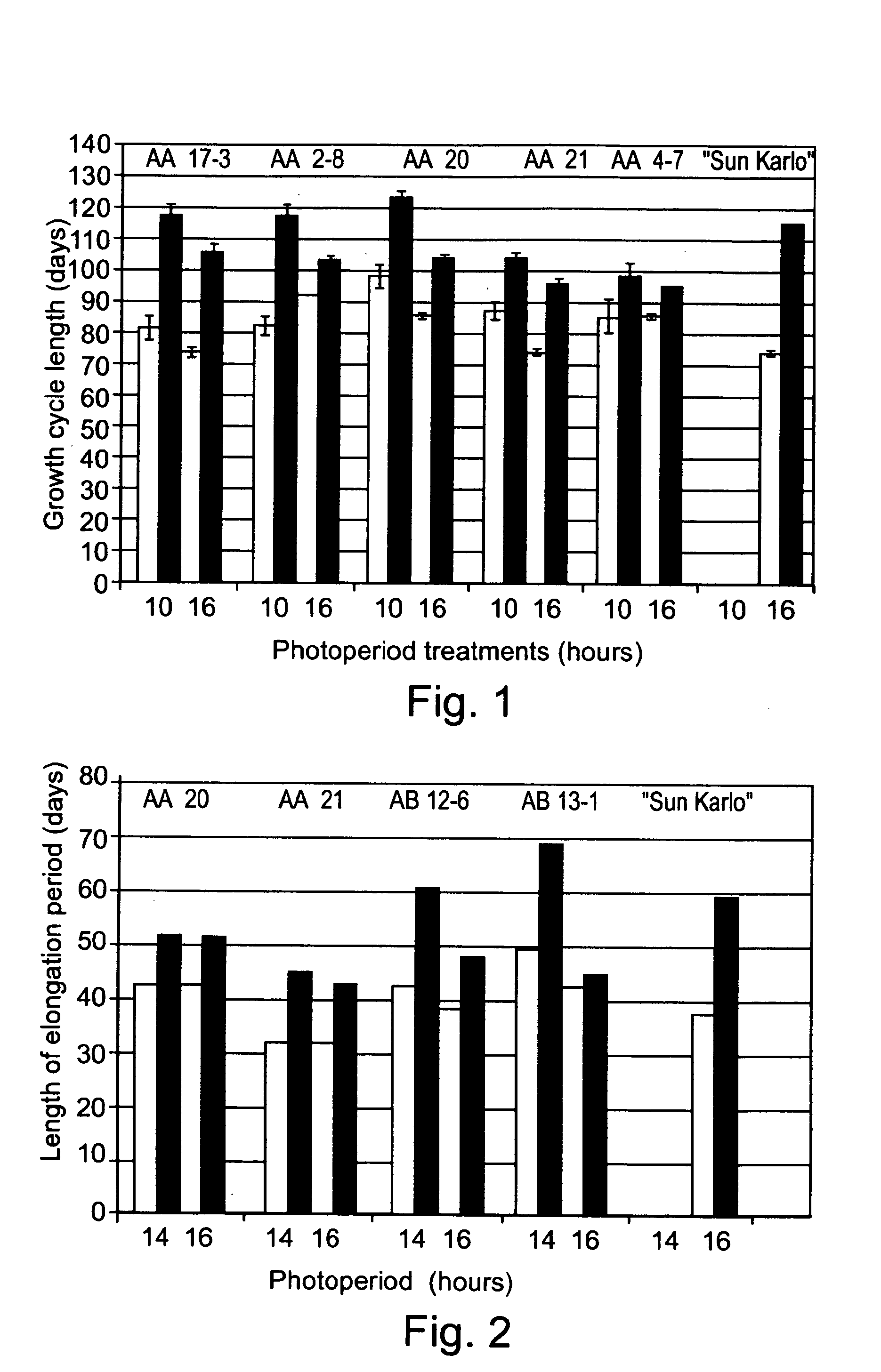Long day plants transformed with phytochrome characterized by altered flowering response to day length
a phytochrome and long-day plant technology, applied in the field of long-day plants characterized by altered flowering response to day length, can solve the problems of only being able to make long-day plants flower earlier, and the growth conditions employed in tissue culture experiments were extremely different from commercial growth conditions, so as to achieve the effect of adjusting the responsiveness to day length
- Summary
- Abstract
- Description
- Claims
- Application Information
AI Technical Summary
Benefits of technology
Problems solved by technology
Method used
Image
Examples
example 1
Generation of Agrobacterium Tumefaciens Harboring Phytochrome A or B Expression Cassettes
[0099] Phytochrome A Expression Cassette:
[0100] An Oat (Avena sativa) phytochrome A polynucleotide fragment which includes a “type 5” (GenBank Accession Number X03244) cDNA and “type 3” (GenBank Accession Number X03242) cDNA was provided in pFY122 (Boylan, M. T. and Quail, P. H., 1989, Plant Cell, 1: 765-773).
[0101] The oat phytochrome A polynucleotide fragment was excised from pFY122 and subcloned into the plasmid pROK2 generating the pRFYI plasmid vector (Smith Harry U.S. Pat. No. 5,945,579). The resultant pRFYI construct included the PHY A sequence subcloned downstream to the CaMV 35S promoter, and upstream to the polyadenylation signal sequences derived from the CaMV 35S transcript. The construct also included a bacterial selection marker for positive bacterial selection and a plant kanamycin-resistance coding sequence for positive plantlets selection (Beyan, M., 1984, Nucleic Acid Resear...
example 2
[0107] Generation and Analysis of Transgenic Aster cv. “Sun Karlo”
[0108]Aster plants were infected with Agrobacterium carrying expression cassettes for either phytochrome A or B in order to generate commercial long day plant characterized by an altered flowering pattern under short day conditions.
[0109] Plant Material:
[0110]Aster plants of cultivar “Sun Karlo” were grown in a controlled environment (phytotrone) in which sunlight was used as light source during at least a part of the photoperiod. In order to keep the plants in their rosette vegetative growth stage, the growing conditions were as follows: [0111] (1) short-day lightning of 10 hours exposure to sun irradiance [0112] (2) controlled temperatures of 20:12° C. during day:night periods respectively.
[0113] Plant Transformation:
[0114] Leaves of rosette shoots were surface sterilized in a 70% (v / v) ethanol for 1 minute followed by 10% (v / v) solution of domestic bleach for 8 minutes. Phytochrome carrying constructs were mobi...
example 3
Response of the Transgenic Aster to Various Day-Length Treatments
[0130] Critical Day Length in Transgenic Aster Plants:
[0131] Table 1 below represents the effect of day extension treatments in the phytotrone on the transition from rosette to inflorescent shoot development and flowering. As mentioned above the plants were exposed to sun irradiance for eight hours. Two hours of day extension were applied either by additional sun irradiance (high light intensity) or artificial light from incandescent and fluorescent lamps (low light intensity).
[0132] According to the data in Table 1 and as shown in FIG. 6, overexpression of phytochrome A considerably shortened the critical day length and enabled inflorescent shoot development and flowering in the transgenic line AA4-7 to occur under day length of eight hours sun irradiance. Day length of 10 hours was short for non-transgenic plants (“Sun Karlo”) and therefore their inflorescent shoots did elongate and as a consequence did not flower...
PUM
| Property | Measurement | Unit |
|---|---|---|
| temperature | aaaaa | aaaaa |
| temperature | aaaaa | aaaaa |
| length | aaaaa | aaaaa |
Abstract
Description
Claims
Application Information
 Login to View More
Login to View More - R&D
- Intellectual Property
- Life Sciences
- Materials
- Tech Scout
- Unparalleled Data Quality
- Higher Quality Content
- 60% Fewer Hallucinations
Browse by: Latest US Patents, China's latest patents, Technical Efficacy Thesaurus, Application Domain, Technology Topic, Popular Technical Reports.
© 2025 PatSnap. All rights reserved.Legal|Privacy policy|Modern Slavery Act Transparency Statement|Sitemap|About US| Contact US: help@patsnap.com



